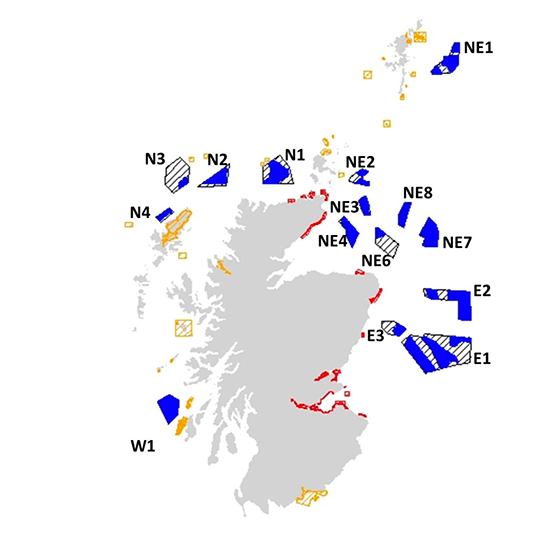Sectoral Marine Plan: roadmap of actions
Road map of actions required to improve our understanding of the potential implications of ScotWind sites on seabirds as identified by the Sectoral Marine Plan.
This document is part of a collection
1. Introduction
The offshore wind industry is set to play a crucial role in Scotland's economy as part of efforts to generate 50% of Scotland's energy from renewable sources by 2030 and to reach Net Zero by 2045. This means that, as we emerge from the COVID-19 pandemic, the industry is likely to play a central role in a green economic recovery.
At present, there are five operational offshore wind farms in Scottish waters, including the world's first floating offshore wind project. A further six are either under construction or have been consented. Building on this success, the recently completed ScotWind Leasing round aimed to deliver additional energy from offshore wind. The Sectoral Marine Plan for Offshore Wind Energy (SMP) set out the spatial Plan Options for the new round of offshore wind seabed leasing, known as ScotWind and managed by Crown Estate Scotland (CES). The SMP assessed the impact of up to 10GW of new development (Figure 1). In January 2022, CES announced that Option Agreements will be offered to 17 projects with a total stated capacity ambition of up to 25GW[1] (Figure 1). Whilst offshore wind energy offers the potential to mitigate the negative impacts of climate change by reducing reliance on fossil fuels, concerns remain over the potential for negative environmental impacts, particularly in relation to birds (Bradbury et al., 2014; Furness et al., 2013; Garthe & Hüppop, 2004). The key effects associated with offshore wind are believed to be collision with turbines, displacement and barrier effects (Cook et al., 2018; Dierschke et al., 2016; Masden et al., 2012; Mendel et al., 2019;Thaxter et al., 2018). Prior to consent for a development being granted, the potential for these impacts to negatively affect populations, particularly those of designated features of protected sites, must be considered as part of the Environmental Impact Assessment (EIA) and Habitats Regulations Appraisal (HRA) processes.
The Strategic Environmental Assessment (SEA)[2] for the Scottish Governments' SMP for Offshore Wind Energy[3] highlighted the potential for negative effects in relation to the Plan Options (POs, Figure 1). Following on from this, the HRA[4] process for the SMP highlighted potential cumulative ornithological impacts as a key constraint to the future delivery of offshore wind in Scottish waters. In five of the POs (E3, NE2, NE3, NE4 and NE6), which include five option agreements with a capacity of up to 4.5 GW, it was determined that further empirical evidence was required before it can be concluded that the risk to seabird populations can be reduced or is at an acceptable level. An additional two sites (E1 and E2) were identified as needing strategic regional surveys and assessments to address uncertainties about the potential cumulative impacts on seabirds, particularly in the non-breeding season.
This work aims to deliver a roadmap to identify actions that will provide an evidence base for assessing ornithological constraints on SMP POs. These projects will then facilitate the ScotWind Iterative Plan Review by identifying immediate research priorities to be undertaken by the Ornithology Working Group and the Scottish Marine Energy Research (ScotMER) programme.

Also shown are Special Protection Areas for which the Strategic Environmental Assessment highlights the potential for negative impacts in relation to the plan options (orange), and for which the Habitats Regulations Appraisal concluded that it was not possible to conclude that there would be no adverse effects on site integrity resulting from development within POs (red) without the applications of mitigation measures discussed above.
Contact
Email: ScotMER@gov.scot
There is a problem
Thanks for your feedback